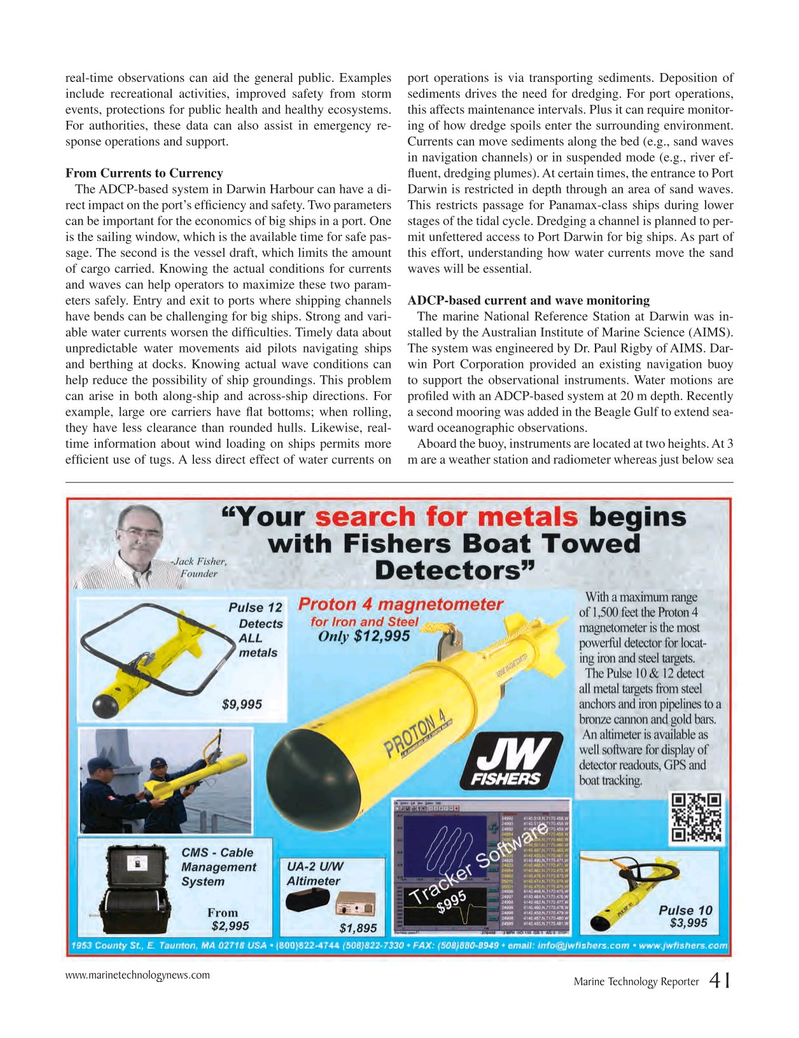
Page 41: of Marine Technology Magazine (September 2016)
Ocean Observation: Gliders, Buoys & Sub-Surface Networks
Read this page in Pdf, Flash or Html5 edition of September 2016 Marine Technology Magazine
real-time observations can aid the general public. Examples port operations is via transporting sediments. Deposition of include recreational activities, improved safety from storm sediments drives the need for dredging. For port operations, events, protections for public health and healthy ecosystems. this affects maintenance intervals. Plus it can require monitor-
For authorities, these data can also assist in emergency re- ing of how dredge spoils enter the surrounding environment. sponse operations and support. Currents can move sediments along the bed (e.g., sand waves in navigation channels) or in suspended mode (e.g., river ef-
From Currents to Currency ? uent, dredging plumes). At certain times, the entrance to Port
The ADCP-based system in Darwin Harbour can have a di- Darwin is restricted in depth through an area of sand waves. rect impact on the port’s ef? ciency and safety. Two parameters This restricts passage for Panamax-class ships during lower can be important for the economics of big ships in a port. One stages of the tidal cycle. Dredging a channel is planned to per- is the sailing window, which is the available time for safe pas- mit unfettered access to Port Darwin for big ships. As part of sage. The second is the vessel draft, which limits the amount this effort, understanding how water currents move the sand of cargo carried. Knowing the actual conditions for currents waves will be essential.
and waves can help operators to maximize these two param- eters safely. Entry and exit to ports where shipping channels ADCP-based current and wave monitoring have bends can be challenging for big ships. Strong and vari- The marine National Reference Station at Darwin was in- able water currents worsen the dif? culties. Timely data about stalled by the Australian Institute of Marine Science (AIMS). unpredictable water movements aid pilots navigating ships The system was engineered by Dr. Paul Rigby of AIMS. Dar- and berthing at docks. Knowing actual wave conditions can win Port Corporation provided an existing navigation buoy help reduce the possibility of ship groundings. This problem to support the observational instruments. Water motions are can arise in both along-ship and across-ship directions. For pro? led with an ADCP-based system at 20 m depth. Recently example, large ore carriers have ? at bottoms; when rolling, a second mooring was added in the Beagle Gulf to extend sea- they have less clearance than rounded hulls. Likewise, real- ward oceanographic observations. time information about wind loading on ships permits more Aboard the buoy, instruments are located at two heights. At 3 ef? cient use of tugs. A less direct effect of water currents on m are a weather station and radiometer whereas just below sea www.marinetechnologynews.com
Marine Technology Reporter 41
MTR #7 (34-49).indd 41 8/24/2016 1:36:47 PM

 40
40

 42
42
